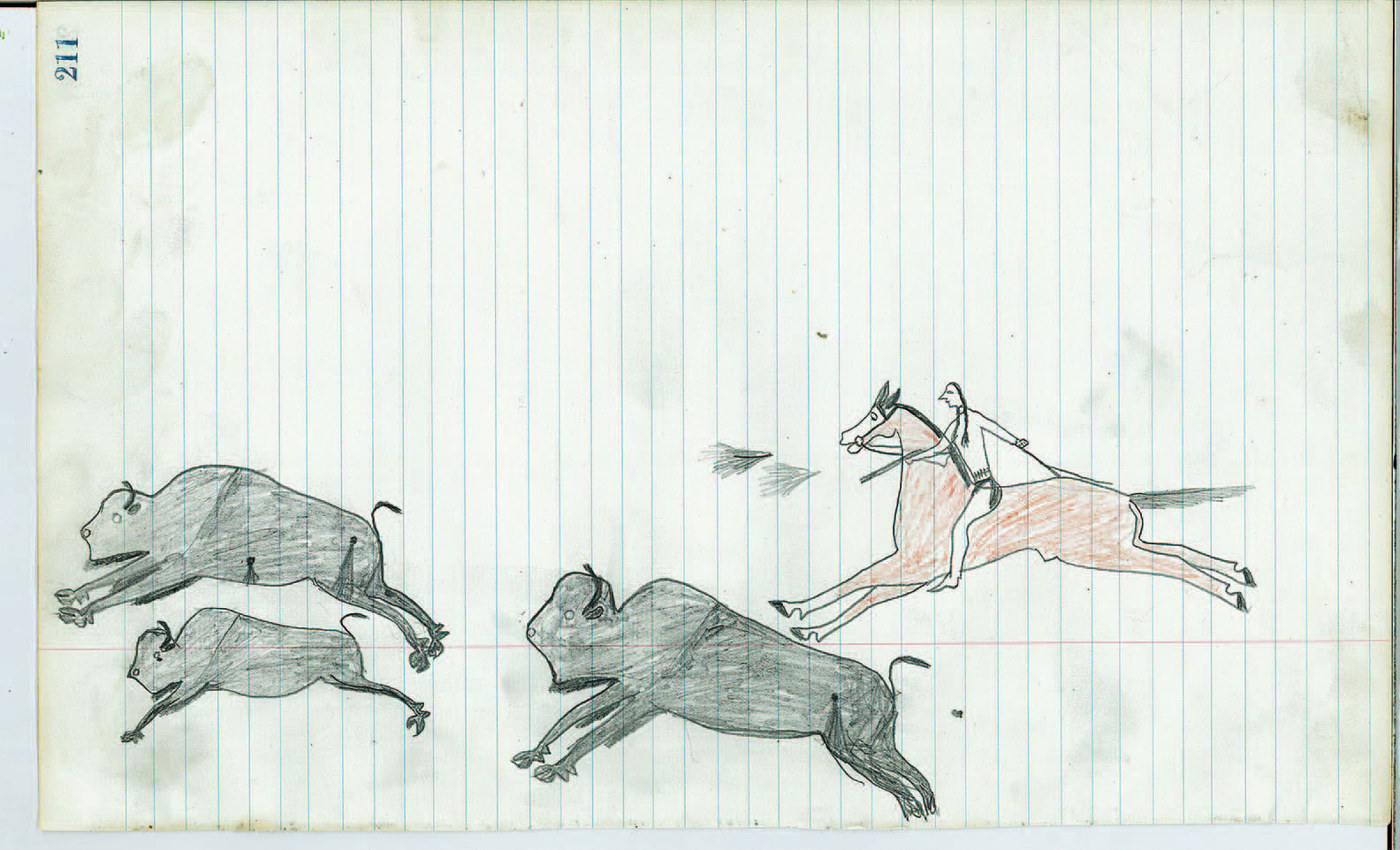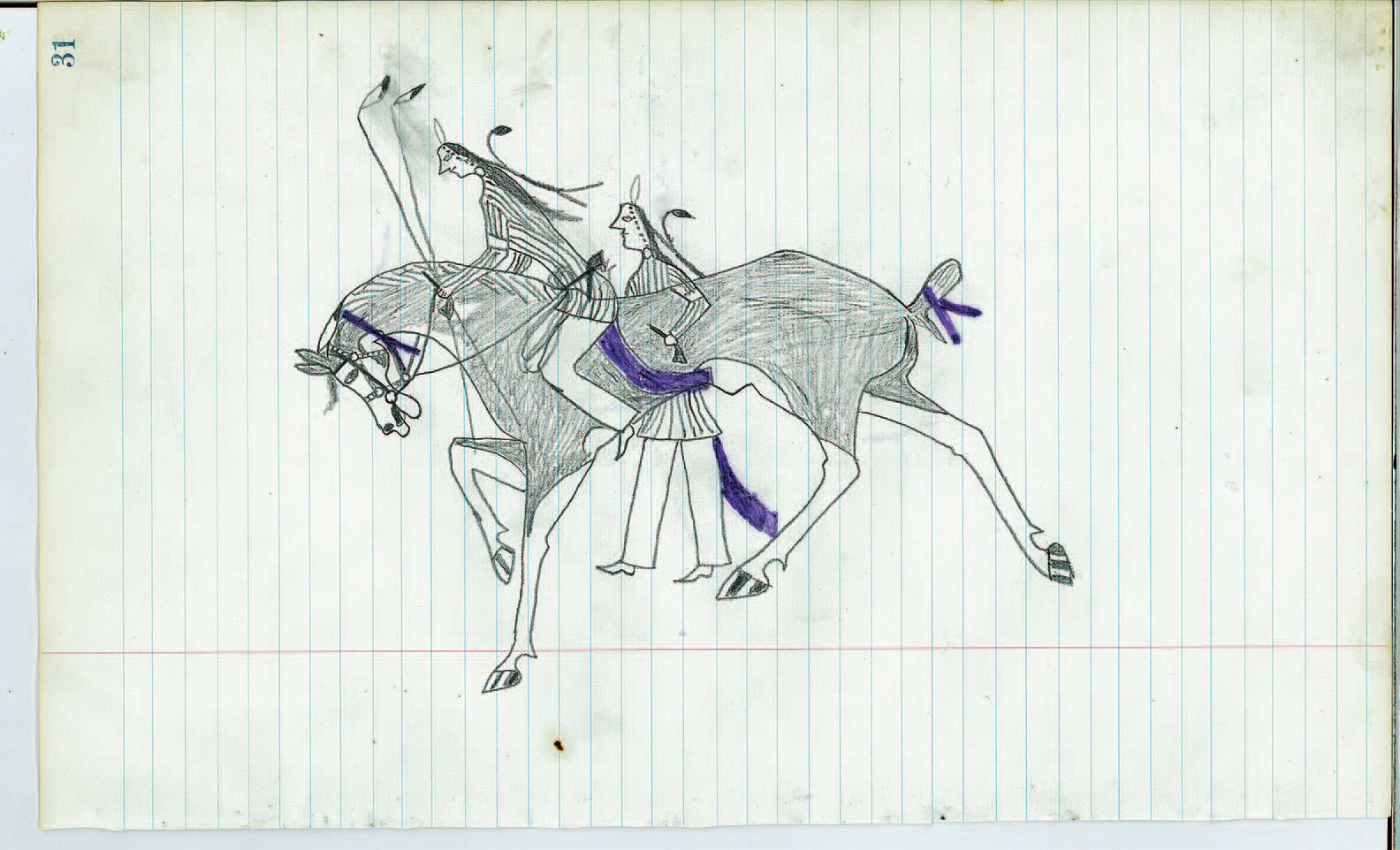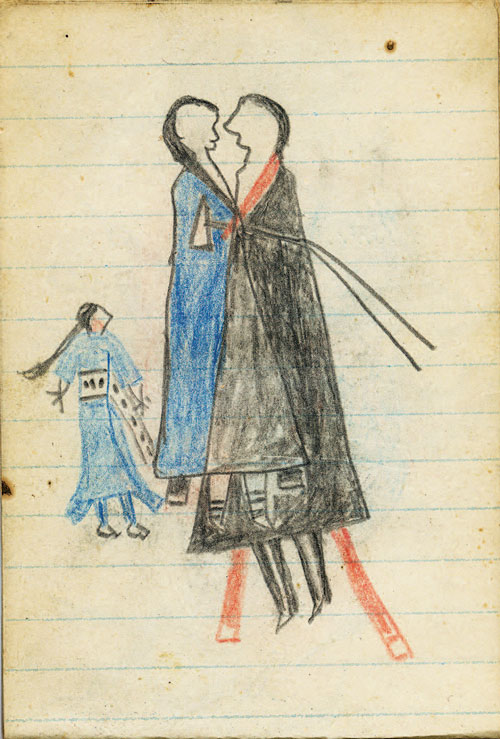Native American Ledger Drawings Became a Form of Tourist Art When

Early on ledger art portrays resistance and resilience on the borderland, while its contemporary pieces tell more than modern stories with similar themes.
Imagine a consummate folio of ledger art — Plains Indian drawings on old financial ledgers — as a class of 19th-century social media. Y'all folio through the drawings, or private "postings," of daring acts, romantic exploits, pictures of friends and family, and personal accounts of pivotal events. Other artists join in, "sharing" their own perspectives.
Just while social media is ubiquitous, antique Indian art is rare, and authentic ledgers are highly coveted. They speak — with an immediacy and intimacy — to a poignant time in American history, a fourth dimension when the great herds of buffalo were disappearing, and the proud tribes that once ruled the Plains were existence relegated to reservations. "Early ledger art is a first-person narrative of history in the Westward," says Henry Monahan, director of Morning Star Gallery in Santa Fe. "It says, 'I was in that location and this is what happened.' "
The earliest examples were done primarily by artists for their own use. Simply their drawings soon became a source of income. "Commercialization of ledger art starts with the Fort Marion artists. It'due south a process of the non-Indian earth appropriating Indian art every bit trophies and souvenirs," says Ross Frank, associate professor of ethnic studies at the University of California, San Diego, and managing director of the Plains Indian Ledger Fine art projection.
Interest in ledger fine art crosses several genres, highly-seasoned to collectors of Native arts, Americana, and Western history. "Information technology's picking up momentum, accessing bigger artistic collecting spheres, and elevating into a more than substantial platform," says Tom Cleary, director of H. Malcolm Grimmer Antique American Indian Art in Santa Fe. "Collectors are drawn to information technology because they can connect with it on a visceral level."
Established collectors tend toward the earlier materials, which can command half-dozen figures. They may be interested in specific tribes, military campaigns, or notable figures such as Red Cloud or Sitting Bull. "Collectors of works on newspaper capeesh the economy of line," Monahan says. "There'south no frame of reference, no landscape of mountains and trees. Notwithstanding information technology tells an emotional story."

Scenes Of The Times
"The pre-1890 work portrays an Indian world that yet existed. After 1890, artists are reminiscing most before times," PILA'due south Ross Frank says. "You find kickoff-person accounts in the 1860s and pictures drawn by bodily warriors. Later boxing scenes are likely done past Indian scouts or individuals employed by the U.S. government. The buffalo herds are gone from the northern Plains, but in southern Plains ledger fine art you nevertheless encounter local deer hunting forth with antelope and turkey. You observe more courting scenes and ceremonial depictions in the later work, partly because the people who owned the battle stories were passing away."
John P. Lukavic, acquaintance curator of Native arts at the Denver Art Museum, agrees. "Conquests through love replaced conquests through warfare. While battle scenes were memories of the past, courting scenes were of the moment." Drawings from the reservation menstruation recount past greatness, depicting ancestors, war exploits from the artists' youth, and ceremonies that were prohibited on the reservation. "Information technology was most a form of cultural resistance."
Because of increased collector interest — and the Antiques Roadshow effect — more ledgers are coming to calorie-free. In 1985, ii important ledgers were establish at a local courthouse sale in Amidon, North Dakota. Many of the drawings were attributed to Jaw, a Hunkpapa Lakota artist.
Scholars adopt that ledger books remain intact, merely many books are leafed out, with drawings sold individually. "Books rarely were done past one artist," Cleary says. "There is growing interest in trying to understand how these books were conceived as entire volumes, and why sure drawings are in certain places. They didn't come up together haphazardly." Cleary's gallery presented works from the Amidon ledger at a selling exhibition at the Heard Museum in February 2017, but the ledger books were digitized by the Plains project and will exist bachelor for public viewing online. Ledgers are to be offered for sale once more August 15 – xviii at the Antiquarian American Indian Fine art Show in Santa Fe.
Space constraints and low-cal sensitivities preclude institutions from permanently displaying their collections. Simply many of the finest ledger art examples are now accessible online, including hundreds of high-resolution images from the Milwaukee Public Museum, the Hood Museum of Art at Dartmouth College, and PILA.

New Takes On The Old Tradition

Contemporary artists working on antique ledger papers hark back to historical art, merely more often than not, they cull to depict modern Native life. They're continuing the chat with an expanded dictionary, and sometimes with biting social and political commentary. Dwayne "Chuck" Wilcox (Oglala Lakota) uses satire and irony in humorous works that hold a mirror to how modern Indians are imagined in works with titles such as Wow! Full Blooded White People! In Terrance Guardipee's (Blackfeet) signature collages, vividly rendered warriors on horseback race across ledgers layered with antique checks and ration cards atop colorful, mod maps, and railroad advertisements.
Women artists are pushing cultural boundaries in this fine art class historically reserved for men. Dolores Purdy (Caddo) began making ledger art when she learned that a relative had been held at Fort Marion in 1875. Her unabashedly commercial work combines pop, psychedelia, and wry visual commentaries on pre-20th century newspaper. Linda Haukaas (Sicangu Lakota) uses historical Lakota motifs in her drawings. Like many contemporary ledger artists, she has expanded the medium to include beadwork and other materials.
The contemporary ledger market is just as robust every bit that of antique drawings; however, prices tend to be lower for gimmicky works. Working artists evidence at Indian markets and powwows across the Westward.
A Collector's Dilemma
Dr. Thomas Jacobsen has a magnificent collection of 22 ledger drawings passed down from his groovy-aunt Mary C. Collins, who worked as a missionary from 1885 to 1910 on the Standing Rock Sioux Reservation. "They gave her the name Winona. She never married, and stayed for 25 years," Jacobsen says. "Sitting Bull even adopted her into the tribe." Collins offered the Sioux paper, pencils, and paints when they visited the mission, and she kept the pictures they drew. Her drove passed down through the family, coming to Dr. Jacobsen after his male parent'southward decease in the 1960s.
It's a familiar story: No one in the family was really aware of the art. "My brother gave me a manila folder with the pictures because he knew I was interested in that kind of thing." They've hung on Jacobsen's walls for decades. "I look at them every twenty-four hour period."
The images are spectacular, depicting warriors and horses on the battleground. In one scene, a Sioux warrior chases a cavalry passenger conveying a flag, which is shown flying upside down. "The artist himself survived and lived to describe it," Jacobsen muses. The pictures are both exciting and personal. "The artists took time drawing these. They wanted these stories told."
Jacobsen wants the drove kept intact and displayed — preferably on a family unit member's wall. However, none of his children or grandchildren tin can do so. "I don't want these to sit in a filing cabinet somewhere," he says. And that'southward a common trouble for owners of family unit collections. Museums eschew accepting collections with stipulations on how the pieces will be used. Even the largest institutions lament the lack of acquisition budgets.
Ross Frank hopes to digitize the drove for PILA, then the pictures Winona's friends created for her may continue to enthrall viewers online for years to come.
Tips for the Collector
Collectors want to examine, experience, and savor ledger art on their walls. But it's on century-one-time newspaper that was never intended to last. So, how do you alive with ledger fine art?
"If you're comfortable, information technology's comfortable," Halvorson says. "Never store it in a basement, which can be clammy, and never in the attic. No directly sunlight. Hang it in a hallway."
"Colored pencil is more robust than other pigment, and the antique papers, peculiarly the military ledgers, tin can exist relatively depression acid," Frank points out. "Fort Marion art tends to exist in commercial sketchbooks, then they concur upwards well."
Growing demand plus readily bachelor antique ledger books equals market mischief. Experts warn that much of the ledger art they run into is faux, and anything on eBay should be viewed with skepticism. Watch for a color palette that'south incorrect, action that doesn't brand sense, or objects being used incorrectly.
"Get knowledgeable and piece of work with a reputable dealer that sees a lot of ledger art. They'll be able to recognize an artist'due south way," advises Lewis Bobrick of Denver's Lewis Bobrick Antiques.
"Collection history is important," Cleary offers. "Does the drawing come from a known volume? New books that come up to market should deport documentation of provenance."
Yous can't go wrong buying the best you can beget, according to Monaghan of Morning Star Gallery: "An unremarkable slice does not compare to a work by a top ledger artist such as Joseph Two Horns or Frank Henderson."
And once you build up your collection, Lukavic suggests trying a variation of what many museums do: "We exhibit drawings for a maximum of half dozen months and so rest them in storage for five years. Why not back up working artists by buying several pieces and rotating them on your walls?"
More on Ledger Art
2 of the Virtually Collectible
A Case of Collecting
Warrior-Artists in a Tourist Boondocks
Drawing History
From the August/September 2017 upshot.
Source: https://www.cowboysindians.com/2017/08/collecting-ledger-art/




Posting Komentar untuk "Native American Ledger Drawings Became a Form of Tourist Art When"